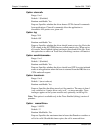
DBS-92-520 Issued April 2000 19
Chapter 5. Maintenance and
Troubleshooting
Alarm Log Entries
Telephony Services Administration allows for the logging and displaying of
messages from a Telephony Services driver. Panadrvr takes advantage of this
service. Note that the actual messages logged, displayed, etc., depend upon
current Novell Tserver settings.
Each message has the following format:
Module ID
: The NLM generating the message, in our case ‘Panadrvr’.
Level
: The importance of the alarm. Telephony Services allows the
following levels:
FATAL: FATAL condition (calling module aborting)
WARNING: non-service-affecting condition
CAUTION: unexpected software error (non-fatal)
ERROR: non-fatal, service-affecting condition
AUDIT_TRAIL: important (normal) event
TRACE: trace message for debugging
Location
: The source code location from where the alarm was generated.
Panadrvr uses the following algorithm:
((Source_Code_Line_Number * 1000) + (Module_ID_Number)).
Thus, for any given alarm the least 3 significant digits represent the Internal
Source Code Module ID while the most significant bits represent the line
number within this module. This selection is intended for Panasonic
Technical Support use only.
Error Code
: Panadrvr uses this value as a cumulative alarm count.
“FATAL” Messages:
These alarms indicate Panadrvr is shutting down.
TDILOGERROR(dname, FATAL, ALMLOC, alarmcnt++, "Unloading
via user request.").
The user has selected the Panadrvr shutdown driver option from the
Panadrvr Menu and Panadrvr is exiting.


















